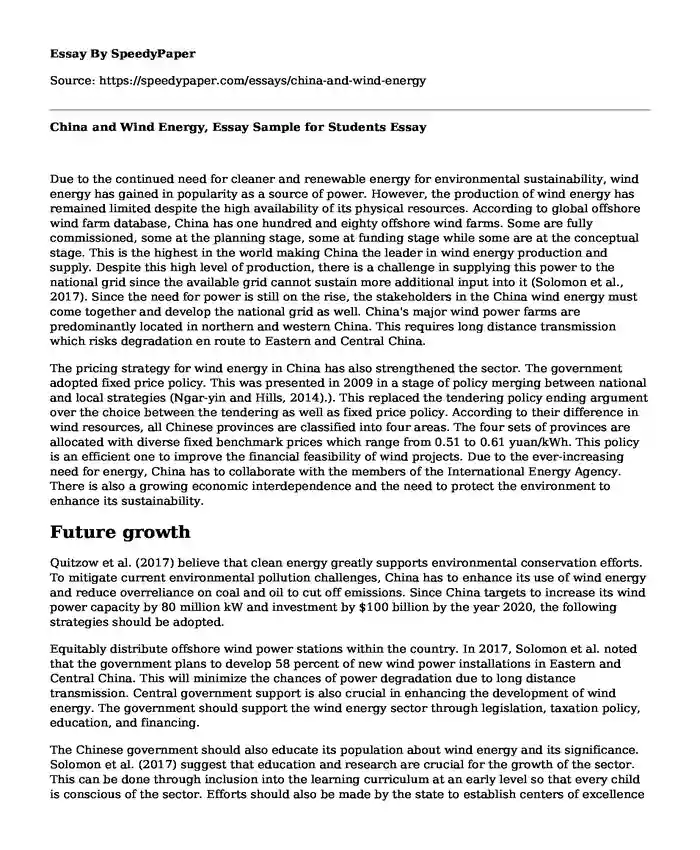Due to the continued need for cleaner and renewable energy for environmental sustainability, wind energy has gained in popularity as a source of power. However, the production of wind energy has remained limited despite the high availability of its physical resources. According to global offshore wind farm database, China has one hundred and eighty offshore wind farms. Some are fully commissioned, some at the planning stage, some at funding stage while some are at the conceptual stage. This is the highest in the world making China the leader in wind energy production and supply. Despite this high level of production, there is a challenge in supplying this power to the national grid since the available grid cannot sustain more additional input into it (Solomon et al., 2017). Since the need for power is still on the rise, the stakeholders in the China wind energy must come together and develop the national grid as well. China's major wind power farms are predominantly located in northern and western China. This requires long distance transmission which risks degradation en route to Eastern and Central China.
The pricing strategy for wind energy in China has also strengthened the sector. The government adopted fixed price policy. This was presented in 2009 in a stage of policy merging between national and local strategies (Ngar-yin and Hills, 2014).). This replaced the tendering policy ending argument over the choice between the tendering as well as fixed price policy. According to their difference in wind resources, all Chinese provinces are classified into four areas. The four sets of provinces are allocated with diverse fixed benchmark prices which range from 0.51 to 0.61 yuan/kWh. This policy is an efficient one to improve the financial feasibility of wind projects. Due to the ever-increasing need for energy, China has to collaborate with the members of the International Energy Agency. There is also a growing economic interdependence and the need to protect the environment to enhance its sustainability.
Future growth
Quitzow et al. (2017) believe that clean energy greatly supports environmental conservation efforts. To mitigate current environmental pollution challenges, China has to enhance its use of wind energy and reduce overreliance on coal and oil to cut off emissions. Since China targets to increase its wind power capacity by 80 million kW and investment by $100 billion by the year 2020, the following strategies should be adopted.
Equitably distribute offshore wind power stations within the country. In 2017, Solomon et al. noted that the government plans to develop 58 percent of new wind power installations in Eastern and Central China. This will minimize the chances of power degradation due to long distance transmission. Central government support is also crucial in enhancing the development of wind energy. The government should support the wind energy sector through legislation, taxation policy, education, and financing.
The Chinese government should also educate its population about wind energy and its significance. Solomon et al. (2017) suggest that education and research are crucial for the growth of the sector. This can be done through inclusion into the learning curriculum at an early level so that every child is conscious of the sector. Efforts should also be made by the state to establish centers of excellence and research centers for offshore wind energy.
Good legislation is also crucial for offshore wind power growth (Quitzow et al. 2017). When there is good legislation for the sector, the government should rally its members to support and pass bills which benefit the sector. The government should also provide financial support for the sector as this will enhance its rapid growth. This can inform of tax incentives for the wind power firms as well as direct funding through private, public partnership.
To clearly understand the offshore wind energy sector in China, there should be collaboration between government, developers, and the communities to carry out research and come up with better strategies for improving the sector.
References
Ngar-yin Mah, D., & Hills, P. R. (2014). Policy Learning and Central-Local Relations: A Case Study of the Pricing Policies for Wind Energy in China (from 1994 to 2009). Environmental Policy and Governance, 24(3), 216-232. doi:10.1002/eet.1639
Quitzow, R., Huenteler, J., & Asmussen, H. (2017). Development trajectories in China's wind and solar energy industries: How technology-related differences shape the dynamics of industry localization and catching up. Journal of Cleaner Production, 158, 122-133. doi:10.1016/j.jclepro.2017.04.130
Solomon, D., Cai, J., & Haacke, O. (2017). New Five-Year Plans Promote Energy Industry Reform. China Business Review, 1.
Cite this page
China and Wind Energy, Essay Sample for Students. (2022, Mar 04). Retrieved from https://speedypaper.net/essays/china-and-wind-energy
Request Removal
If you are the original author of this essay and no longer wish to have it published on the SpeedyPaper website, please click below to request its removal:
- HR Essay Sample: Post-Training Evaluation Plan
- Free Essay: Aspects of Disneyland That Were Changed When Disney Paris Was Constructed
- Cognitive model
- Personal Experience Essay: My Experiences as a Dominican Latino
- Narrative Reporting Essay Sample
- Free Essay with Literary Analysis for "A Christmas Carol"
- Free Essay: Dual Admission Program
Popular categories





